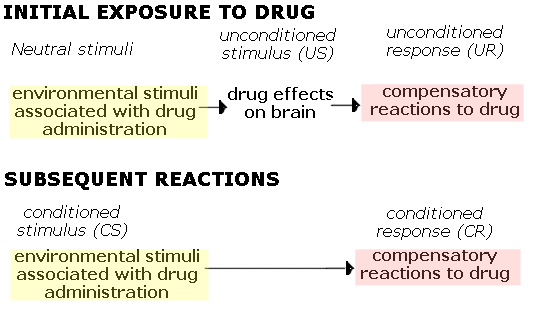Nov 7, 2013 | By Tim Powers
Classical Conditioning and Addiction
Mental HealthIn order to try and grasp the mechanisms that drive addictive behaviors and addiction, it can be helpful to use concepts that may already be familiar. One of those concepts that may help people understand the underpinnings of addiction is the concept of classical conditioning. The concept of classical conditioning (also called respondent conditioning) is commonly taught in introductory psychology classes. What are the connections between classical conditioning and addiction? Understanding the links between classical conditioning and addiction may uncover why some people succumb to the temptations of drugs and alcohol while others do not fall prey to those temptations.
Classical Conditioning: A Review
Classical conditioning was the discovery of a Russian physiologist by the name of Ivan Pavlov. Throughout the course of his researching career, Pavlov was investigating the automatic reflexes of animals when he made his discovery of the classical conditioning principle. In brief, classical conditioning means that a specific stimulus causes specific responses. The most common example of classical conditioning is that when food is seen there may be a salivary response.
While salivating when seeing the food stimulus may be seen as an automatic response, there is a learning aspect to classical conditioning that also needs to be taken into consideration. In one of his most famous experiments, Pavlov rang a bell every time he fed some dogs. The bell in this situation was paired with the arrival of the food. While food in of itself can be considered an unconditioned stimulus since food itself can cause the salivation, the ringing of the bell paired with the arrival of the food is seen as a conditioned stimulus.
Eventually, the dogs learned to associate the ringing of the bell to the delivery of their food and after enough repetitions the ringing of the bell could elicit the same response as the food itself: salivation.
How Classical Conditioning and Addiction Relate to One Another
The question is how does classical conditioning and addiction relate to one another? Like the example of the bell ringing when the food was on its way for the dogs, there can be certain relapse triggers that can have the same effect on the addicted person. Those relapse triggers can be certain smells, places, and situations that have a strong connection to the actual act of using. For example, someone could come home from work and always drink in front of the television or they may always smoke marijuana in the car. In those cases, the television and the car can be seen as conditioned stimuli. In both situations, those settings (sitting in front of the television or being in the car) create powerful cravings (like the salivation in the dogs) and those cravings can lead to relapse behaviors.
Possible Treatment Options
In regards to classical conditioning and addiction, there may be some options available that can weaken those stimulus associations. Cue exposure therapy is one possible treatment option and focuses on those cues (sights, smells, sounds, etc.) that can be seen as the conditional stimuli that can lead to cravings and thus relapse behaviors. By repeatedly exposing someone to those cues without engaging in the actual behavior, the cues could lose their power. The goal in cue exposure therapy is to lessen the power of cues and not complete elimination of those cues since it would be impossible to eliminate all cues.
Also in regards to the links between classical conditioning and addiction, therapists may use classical conditioning itself to diminish or remove unwanted behaviors. An example of this is aversion therapy, where there is an intentional paired association between unwanted behavior and an unwanted experience. An example that can be used is the use of Anabuse. If a person takes anabuse and drinks alcohol, there are averse physical reactions to the alcohol felt in the body. What was once seen as a positive association is turned negative. However, aversion therapy is not a long term protocol but can be used in conjunction with lifestyle changes.
The effects of classical conditioning have been noted for decades, but only in recent memory have the concepts of classical conditioning and addiction been thought about and studied. Understanding the adapting the paradigms of conditioned and unconditioned stimuli and ways to weaken their associations in relation to addiction can be another viewpoint that can be used to understand the mechanisms of addiction.

jill mendenhall
11 years ago
I keep switching addictions help
john smith
11 years ago
Choosing the lesser of two evils is still choosing evil. Although, it’s better to have a dollar and need two, than to live under a bridge. I made the second part up, that’s why it sounds weird. I’m struggling too, I think just keep reaching out until you have reached the person that reaches back and grabs and helps you. Never give up 🙂
john smith
11 years ago
Sometimes you can find the light in the strangest of places if you look at it right.
Recent Articles
Xanax Abuse: Warning Signs & Symptoms Of Xanax Addiction And Abuse
Warning Signs of a Drug Relapse: Spot Them Early
How to Quit Cocaine: Overcoming Addiction & Withdrawal Symptoms
Non 12 Step Fellowships for Flexible Recovery
What are 12-Step Programs? Explore Their Principles and Impact?
Question About Treatment
Get Confidential help 24/7
(866) 207-7436Who Answers
Contact Sober Nation's Sponsored Hotline
If you are seeking drug and alcohol related addiction rehab for yourself or a loved one, the SoberNation.com hotline is a confidential and convenient solution.
Calls to any general hotline (non-facility) will be answered by Treatment Addiction Solutions
Alternatives to finding addiction treatment or learning about substance:
If you wish to contact a specific rehab facility then find a specific rehab facility using our treatment locator page or visit SAMHSA.gov.
To learn more about how Sober Nation operates, please contact us